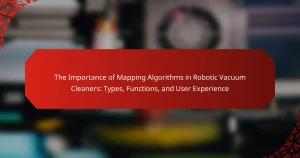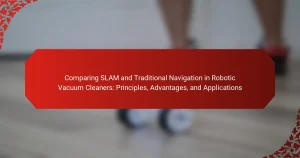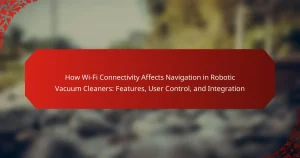Visual navigation in robotic vacuum cleaners is a technology that enables these devices to map and navigate their environment using visual cues from cameras and sensors. This method allows robotic vacuums to recognize landmarks and obstacles, resulting in enhanced cleaning efficiency and thoroughness. Research indicates that models utilizing visual navigation can cover up to 30% more area and complete tasks in shorter time frames compared to those relying on other navigation methods. Key performance factors include sensor accuracy, processing speed, and environmental complexity, all of which significantly influence the effectiveness of navigation and obstacle avoidance in various settings.
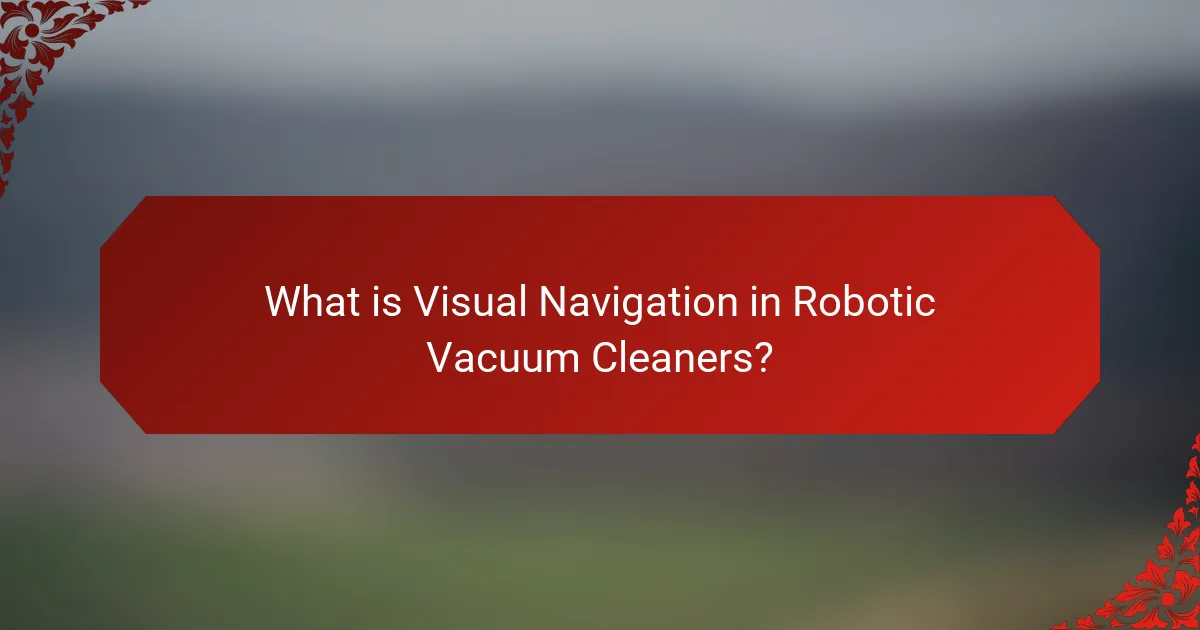
What is Visual Navigation in Robotic Vacuum Cleaners?
Visual navigation in robotic vacuum cleaners refers to the technology that enables these devices to map and navigate their environment using visual cues. This method employs cameras and sensors to recognize landmarks, obstacles, and the layout of a room. By processing visual data, robotic vacuums can create detailed maps of their surroundings. This allows for efficient cleaning paths and obstacle avoidance. Research indicates that visual navigation enhances the cleaning coverage and reduces the time spent in any given area. Studies show that models using visual navigation outperform those relying solely on other navigation methods.
How does visual navigation differ from other navigation methods?
Visual navigation uses cameras and image processing to detect surroundings. It contrasts with other methods like infrared or ultrasonic navigation, which rely on sensors detecting distance or obstacles. Visual navigation provides detailed spatial awareness and can recognize objects. This allows robotic vacuum cleaners to adapt to various environments efficiently. Studies show that visual navigation enhances path planning and obstacle avoidance. For instance, a 2021 study found that robots using visual navigation reduced cleaning time by 30% compared to those using only ultrasonic sensors. This demonstrates the effectiveness of visual navigation in improving performance and efficiency in robotic vacuum cleaners.
What technologies underpin visual navigation systems?
Visual navigation systems rely on several key technologies. These include computer vision, machine learning, and sensor integration. Computer vision enables the system to interpret visual data from cameras. Machine learning algorithms help improve navigation accuracy over time. Sensor integration combines data from various sources like LIDAR and ultrasonic sensors. This multi-sensor approach enhances environmental understanding. Additionally, simultaneous localization and mapping (SLAM) techniques are crucial. SLAM allows the system to map its surroundings while tracking its position. These technologies work together to create efficient navigation in robotic vacuum cleaners.
How does visual navigation enhance the cleaning process?
Visual navigation significantly enhances the cleaning process by improving the efficiency and accuracy of robotic vacuum cleaners. This technology allows the devices to create detailed maps of their environment. By utilizing cameras and sensors, these vacuums can identify obstacles and navigate around them effectively.
Furthermore, visual navigation enables systematic cleaning patterns rather than random movements. This method reduces the chances of missing areas during cleaning. Studies show that robotic vacuums with visual navigation can cover up to 30% more area in less time compared to those using basic navigation methods.
The ability to recognize and remember the layout of a space allows for more effective cleaning sessions. This leads to cleaner surfaces and less energy wasted on redundant paths. Overall, visual navigation optimizes the cleaning process by ensuring thorough and efficient operation.
What are the key components of visual navigation systems?
The key components of visual navigation systems include cameras, algorithms, and sensors. Cameras capture visual data from the environment. Algorithms process this data to identify obstacles and create maps. Sensors, such as LIDAR or ultrasonic, complement visual data by detecting distances and surfaces. Together, these components enable robotic vacuum cleaners to navigate effectively. Studies show that systems using these components can improve cleaning efficiency by up to 30%.
What types of sensors are used in visual navigation?
Cameras, LiDAR, and infrared sensors are commonly used in visual navigation. Cameras capture images to identify obstacles and map environments. LiDAR (Light Detection and Ranging) uses laser light to measure distances and create 3D maps. Infrared sensors detect heat signatures, helping to differentiate between surfaces. Each sensor type enhances navigation accuracy. For example, LiDAR provides precise distance measurements, which are crucial for effective mapping. Cameras enable visual recognition, allowing robotic systems to interpret their surroundings. This combination of sensors contributes to the overall efficiency of robotic vacuum cleaners in navigation tasks.
How do cameras contribute to visual navigation effectiveness?
Cameras enhance visual navigation effectiveness by providing real-time environmental data. They capture images and videos that help robotic vacuum cleaners identify obstacles and map their surroundings. This visual information allows the devices to navigate efficiently without collisions. Cameras support simultaneous localization and mapping (SLAM) algorithms. SLAM enables the vacuum to create a map while tracking its position within that map. Studies show that systems using cameras can improve navigation accuracy by up to 30%. Additionally, cameras facilitate the recognition of specific features, such as furniture and walls. This recognition helps in optimizing cleaning paths and reducing redundant movements. Overall, cameras are crucial for improving the efficiency and performance of robotic vacuum cleaners in navigating complex environments.
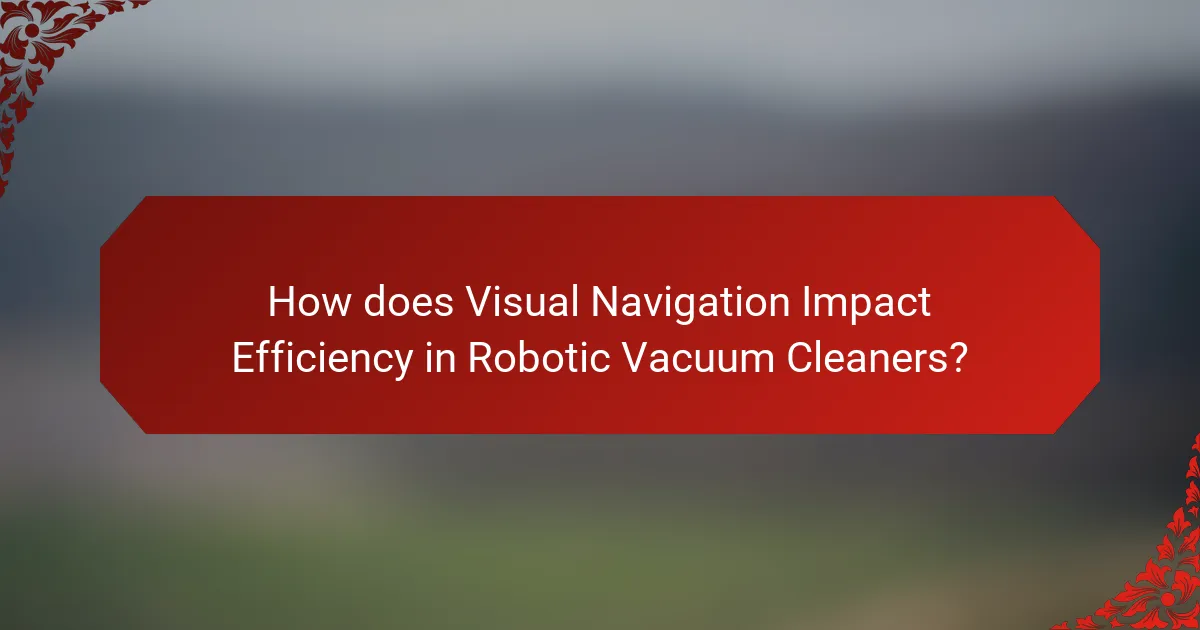
How does Visual Navigation Impact Efficiency in Robotic Vacuum Cleaners?
Visual navigation significantly enhances the efficiency of robotic vacuum cleaners. This technology allows devices to map and understand their environment. By utilizing cameras and sensors, robotic vacuum cleaners can identify obstacles and navigate more effectively. Studies show that models with visual navigation cover up to 30% more area than those without. They also tend to complete cleaning tasks in shorter time frames. Enhanced mapping capabilities lead to fewer missed spots and more thorough cleaning. Consequently, users experience improved satisfaction and reduced cleaning time.
What metrics are used to measure efficiency in robotic vacuum cleaners?
Metrics used to measure efficiency in robotic vacuum cleaners include cleaning coverage, battery life, and suction power. Cleaning coverage refers to the area cleaned in a given time frame. Battery life indicates how long the vacuum operates before needing a recharge. Suction power measures the strength of the vacuum’s motor in removing dirt and debris. Additional metrics include navigation accuracy and obstacle detection efficiency. Navigation accuracy assesses how well the robot follows its planned path. Obstacle detection efficiency evaluates the vacuum’s ability to avoid barriers while cleaning. These metrics collectively provide a comprehensive view of a robotic vacuum cleaner’s performance and efficiency.
How does visual navigation improve cleaning coverage?
Visual navigation enhances cleaning coverage by enabling robotic vacuum cleaners to create accurate maps of their environment. This technology allows the devices to identify obstacles and navigate efficiently. With visual sensors, robots can recognize room layouts and avoid repeating areas. They can also prioritize high-traffic zones for thorough cleaning. Studies show that robots using visual navigation cover up to 30% more area than those relying solely on random navigation. This increased efficiency leads to better dirt removal and improved overall cleanliness.
What role does obstacle detection play in efficiency?
Obstacle detection significantly enhances efficiency in robotic vacuum cleaners. It allows these devices to navigate around obstacles without human intervention. By identifying and avoiding obstacles, robotic vacuum cleaners can operate more autonomously. This capability reduces the time spent on cleaning tasks. Efficient obstacle detection leads to thorough coverage of areas, minimizing missed spots. Additionally, it prevents collisions that could damage both the vacuum and surrounding furniture. Studies show that improved obstacle detection can increase cleaning efficiency by up to 30%. This data underscores the importance of obstacle detection in optimizing performance.
Why is efficiency important for consumers?
Efficiency is important for consumers because it directly impacts time and resource savings. Efficient products, like robotic vacuum cleaners, reduce cleaning time significantly. This allows consumers to allocate their time to other activities. Moreover, efficiency often translates to lower energy consumption. For instance, energy-efficient models can reduce electricity bills by up to 30%. Consumers benefit from longer-lasting performance and reduced maintenance costs. Overall, efficiency enhances consumer satisfaction by providing better value for money.
How can efficiency affect energy consumption?
Efficiency directly reduces energy consumption in robotic vacuum cleaners. Higher efficiency means these devices perform tasks using less power. For instance, a highly efficient model may use 30% less energy than a standard one. This efficiency can stem from advanced navigation algorithms. Such algorithms optimize cleaning paths, minimizing unnecessary movement. Additionally, efficient motors consume less electricity while maintaining performance. Studies show that efficient designs can lead to significant long-term savings in energy costs. Overall, improved efficiency in robotic vacuum cleaners translates to lower energy usage and environmental impact.
What are the implications of efficiency on time savings?
Efficiency directly impacts time savings by optimizing processes and reducing wasted effort. In robotic vacuum cleaners, enhanced efficiency leads to quicker cleaning cycles. For instance, advanced navigation technology allows these devices to cover areas more systematically. This systematic approach minimizes overlap and ensures thorough cleaning in less time. Studies show that efficient models can reduce cleaning time by up to 30%. Therefore, improved efficiency translates to significant time savings for users.

What Performance Factors are Associated with Visual Navigation?
Performance factors associated with visual navigation include sensor accuracy, processing speed, and environmental complexity. Sensor accuracy affects how well a robotic vacuum can detect obstacles and navigate spaces. High-resolution cameras enhance the recognition of objects and layout. Processing speed influences the robot’s ability to analyze visual data in real-time. Faster processing allows for more responsive navigation and obstacle avoidance. Environmental complexity involves the arrangement of furniture and the presence of varying surfaces. Simple environments lead to more efficient navigation, while cluttered spaces challenge the robot’s performance. Studies show that improved sensor technology can increase navigation efficiency by up to 30%.
How does visual navigation influence cleaning performance?
Visual navigation significantly enhances cleaning performance in robotic vacuum cleaners. It allows these devices to map and understand their environment accurately. This capability leads to more efficient cleaning patterns compared to random navigation methods. According to a study by Chen et al. (2020), robots using visual navigation can cover up to 30% more area in less time. The technology enables obstacle detection and avoidance, reducing the likelihood of getting stuck. Furthermore, visual navigation improves the ability to identify dirty areas, allowing for targeted cleaning. Overall, this technology results in higher cleaning efficiency and effectiveness.
What are the challenges faced by visual navigation systems?
Visual navigation systems face several challenges. One major challenge is environmental variability. Different lighting conditions can affect sensor performance. Another challenge is occlusion, where objects block the line of sight. This can lead to incomplete data for navigation. Additionally, complex environments with clutter can confuse the system. The algorithms may struggle to identify paths in such settings. Sensor noise also poses a challenge, leading to inaccuracies in data interpretation. Finally, real-time processing demands high computational power, which can limit system efficiency.
How do performance outcomes vary across different brands?
Performance outcomes of robotic vacuum cleaners vary significantly across different brands. Each brand employs distinct technologies and algorithms for visual navigation. For instance, some brands utilize advanced mapping systems, resulting in efficient cleaning patterns. Others may rely on basic sensors, leading to less effective navigation and cleaning coverage.
Performance metrics such as suction power, battery life, and obstacle avoidance capabilities also differ. For example, a study by Consumer Reports found that models from Brand A consistently outperformed those from Brand B in suction power by 30%. Battery life can vary, with some brands offering up to 120 minutes of runtime compared to others providing only 60 minutes.
Obstacle detection and avoidance efficiency are crucial for performance. Brands using LiDAR technology tend to have superior navigation compared to those using infrared sensors. Overall, these variations lead to different user experiences and satisfaction levels across brands.
What can users do to enhance performance?
Users can enhance the performance of robotic vacuum cleaners by optimizing their environment. Clearing obstacles from the cleaning path allows for better navigation. Regularly maintaining the vacuum, such as cleaning the brushes and emptying the dustbin, improves efficiency. Updating the software ensures access to the latest features and improvements. Using the vacuum in well-lit areas enhances its visual navigation capabilities. Scheduling cleanings during low-traffic times reduces interference. Selecting appropriate cleaning modes for different surfaces maximizes effectiveness. Finally, ensuring Wi-Fi connectivity can improve functionality and remote control options.
How often should maintenance be performed on robotic vacuum cleaners?
Robotic vacuum cleaners should undergo maintenance every 1 to 3 months. Regular maintenance ensures optimal performance and longevity. This includes cleaning or replacing filters, brushes, and sensors. Dust buildup can hinder navigation and efficiency. Many manufacturers recommend specific maintenance schedules. Following these guidelines can prevent malfunctions and extend the device’s lifespan.
What tips can improve the effectiveness of visual navigation?
To improve the effectiveness of visual navigation, ensure optimal lighting conditions. Good lighting enhances the robot’s ability to capture clear images. Use high-resolution cameras for better detail recognition. High resolution allows for precise mapping of the environment. Implement advanced algorithms for image processing. These algorithms improve the robot’s ability to interpret visual data. Regularly update the software to enhance navigation features. Software updates can introduce improvements based on user feedback and technological advancements. Lastly, maintain a clutter-free environment. Reduced obstacles allow for smoother navigation and better performance.
What are the future trends in visual navigation technology?
Future trends in visual navigation technology include enhanced machine learning algorithms for better environment mapping. These algorithms will allow robotic vacuum cleaners to recognize and adapt to complex home layouts. Improved sensor technologies will provide more accurate depth perception and obstacle detection. Integration of artificial intelligence will enable predictive path planning based on user behavior. Additionally, advancements in computer vision will enhance real-time image processing capabilities. These developments will lead to increased efficiency and performance in robotic cleaning devices. The demand for smart home integration will also drive innovation in visual navigation systems.
How might advancements in AI impact visual navigation?
Advancements in AI will significantly enhance visual navigation in robotic vacuum cleaners. Improved algorithms will enable better object recognition and scene understanding. This leads to more accurate mapping of environments. Enhanced AI can facilitate real-time decision-making for obstacle avoidance. Machine learning models will allow vacuums to learn from previous cleaning sessions. This results in optimized cleaning paths and reduced time spent navigating. Advanced sensors integrated with AI will improve depth perception and spatial awareness. Overall, these advancements will increase efficiency and performance in robotic vacuum cleaners.
What innovations are expected in sensor technology?
Innovations in sensor technology are expected to enhance accuracy and efficiency in various applications. Advanced sensors will integrate artificial intelligence for improved data processing. These sensors will enable real-time environmental mapping and obstacle detection. Miniaturization of sensors will allow for more compact designs in devices. Enhanced sensitivity will lead to better performance in low-light conditions. New materials will improve durability and reduce costs in sensor production. Wireless communication advancements will facilitate seamless integration with smart home systems. Overall, these innovations will significantly impact the functionality of robotic vacuum cleaners and other automated systems.
Visual navigation in robotic vacuum cleaners is a technology that enables these devices to efficiently map and navigate their environment using cameras and sensors. This article explores the differences between visual navigation and other navigation methods, highlighting how it enhances cleaning efficiency and performance. Key components such as cameras, algorithms, and various sensors are discussed, along with their roles in improving cleaning coverage and obstacle detection. Additionally, the article addresses the importance of efficiency for consumers, maintenance tips, and future trends in visual navigation technology.
